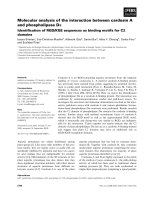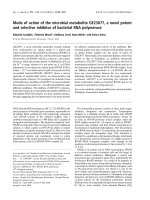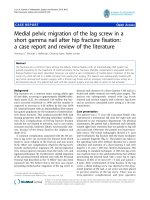Ebook CT and MRI of the abdomen and pelvis - A teaching file (3rd edition): Part 2
Bạn đang xem bản rút gọn của tài liệu. Xem và tải ngay bản đầy đủ của tài liệu tại đây (39.47 MB, 115 trang )
CLINICAL HISTORY 34-yUJr-old man presenting with left upper quadrant pain.
FIGURE
80A
FIGURE
soc
FIGURE
SOB
FIGURE
SOD
FINDINGS Axial CECf (A) demonstrates two geographic
of low attenuation. These lesions are best demonstrated on
hypo-attenuating areas in the spleen. Axial T2-WI (B) shows
an additional round lesion more inferiorly, which bas bright
DIAGNOSIS Splenic infarcts.
CECT image. During the acute stage, infarcts are ill-defined
and heterogeneously hyperdense due to areas of hemorrhage
within them. MRI best shows the internal hemorrhage on
the Tl-WI, as in this case. As an infarct begins to fibrose, it
will appear better demarcated and may cause contraction of
the sWTOunding nmmal spleen. When serial CT scans demonstrate progressive liquefaction and necrosis with outward
extension, developing subcapsular hemorrhage, and free
peritoneal hematoma, the possibility ofimpending rupture or
superimposed infection should be considered.
DISCUSSION There are multiple causes for splenic
infarcts, including emboli, hematologic diseases, portal
hypertension, and iatrogenic causes. In patients younger
than 40 years, hemoglobinopathies are the most common
cause of splenic infarction. Infarcts can have a variety of
CT appearances ranging from the classic peripheral wedgeshaped defect to focal round lesions and ill-defined areas
Even though infarcts are typically wedge-shaped, on
axial images, they may appear round, as in this case,
depending on how the wedge--shaped area is "cut" on the
image; this is more commonly seen in infarcts in the superior and inferior aspects of the spleen. Coronal or sagittal
reformatted images would show best the true wedgeshaped configuration of the abnormality.
signal. On the fat-suppressed axial Tl-WI (C), one lesion has
a spontaneously bright curvilinear central area. No enhancement is seen on the gadolinium-enhanced, fat-suppressed
axial Tl-WI (D).
DIFFERENTIAL DIAGNOSIS Splenic laceration, fracture.
103
CLINICAL HISTORY 37-year-old woman presenting with known steatohepatitis
and alcohol abuse.
FIGURE
81A
FIGURE B1C
FIGURE
818
FIGURE
FINDINGS Axial MRI demonstrate marked enlargement
of the lateral segment of the left lobe of the liver and concomitant decrease in the size of the right liver lobe. An illdefined wedge-shaped area within the medial segment of the
left liver lobe shows increased signal intensity on the axial
1'2-WI (A), decreased signal intensity on the fat-suppressed
axial Tl-WI (B), and delayed enhancement on gadoliniumenhanced, fat-suppressed axial Tl-WI (C and D). Hepatic
vessels are seen traversing through this region without the
evidence of distortion. Also note the capsular retraction adjacent to the abnormal area.
DIFFERENTIAL DIAGNOSIS Hepatocellular carcinoma,
intrahepatic cholangiocarcinoma.
DIAGNOSIS Confluent hepatic fibrosis.
104
810
DISCUSSION Confluent hepatic fibrosis can present as
a masslike area (14%) in patients with underlying cirrhosis,
especially primary sclerosing cholangitis. It typically affects
the anterior segments of the right lobe and medial segments of
the left lobe. Confluent hepatic fibrosis usually has a wedgeshaped appearance, but in some patients, the entire segment
might be involved. The typical appearance of confluent
hepatic fibrosis is an area of low signal intensity on Tl-WI
and high signal intensity on T2-WI. It usually demonstrates
delayed enhancement on gadolinium-enhanced images. The
typical geographic pattern of involvement and retraction of
the ovttlying hepatic capsule can be helpful in diagnosing this
condition. Possible explanations for the hyperintense appearance of confluent fibrosis on T2-WI are a relative reduction in
the signal of the remaining liver parenchyma due to increased
iron deposition, edema due to venous thrombosis, or most
likely, inflammatory changes within the fibrosis.
CLINICAL HISTORY 22-year-old man presenting with abdominal pain and
tenderness.
FIGURE
FIGURE
82A
828
FINDINGS Axial CECT images (A-D) demonstrate highdensity ascites as well as a thick enhancing peritoneum.
There are also omental and retroperitoneal lymph nodes.
DIFFERENTIAL DIAGNOSIS Peritoneal carcinomatosis,
malignant mesothelioma.
DIAGNOSIS Tuberculosis peritonitis and omentitis.
DISCUSSION Although tuberculosis is unusual in Western
countries, there has been an increased incidence of tuberculosis due to the large number of chronically immunosuppresse
patients due to transplantation mv infection, and other causeA.
Extrapulmonary tuberculosis has proportionally also increased,
FIGURE
82C
FIGURE
820
reaching up to 15% of new cases of tuberculosis documented in
the United States. Furt:hermore, in only 15% ofcases ofabdom-
inal tuberculosis, there is pulmonary disease. Ascites due to
tuberculosis has high attenuation (20 to 4S lRJ) due to the high
protein and cellular contentB.
also demonstrates peritoneal
thickm:i:ng, enhancement, and sometimes nodularity corresponding to the tuberculomas present in it. Omental caking can
be seen in up to 82% of patients with abdominal tuberculosis.
Peritoneal carcinomatosis is very difficult to distinguish from
tuberculou.s peritonitis except for the fact that, in the latter, there
is history of a known malignancy. Peritoneal mesothelioma can
also produce some of the findings seen in tuberculous peritonitis, but the peritoneal thickening is much more pronounced, and
the ascites is less massive than in tuberculosis.
cr
105
CLINICAL HISTORY 49-year-old man with chronic affective disorder presenting
with lower abdominal pain.
FIGURE 83A
FIGURE
B3C
838
FIGURE
830
FIGURE
FINDINGS Axial (A and B), coronal reformatted (C), and
sagittal reformatted (D) CECT images demonstrate innumerable microcysts in the cortex and medulla of both kidneys.
DIFFERENTIAL DIAGNOSIS Glomerulocystic kidney
disease, autosomal recessive polycystic kidney disease, autosomal dominant polycystic kidney disease.
DIAGNOSIS Chronic lithium nephropathy.
DISCUSSION Chronic lithium nephropathy is a progressive condition causing interstitial fibrosis and dilatation of
distal tubules with formation of microcysts. These microcysts are identified in 63% of renal biopsy specimens of
106
patients on chronic lithium therapy. The cysts are present in
both the cortex and the medulla and measure 1 to 2 mm in
size. Progressive decrease in renal function is seen in chronic
lithium nephropathy. On the other hand, glomerulocystic
kidney disease, occurring in sporadic or familial forms, is
characterized by cystic dilatation of Bowman's capsule; the
cysts are therefore entirely cortical in distribution, a key distinguishing factor. Patients with autosomal recessive polycystic kidney disease (ARPKD) present in the early life with
multiple small renal cysts in massively enlarged kidneys.
The juvenile form of ARPKD presents in adolescence with
associated findings of portal hypertension. The kidneys of
patients with autosomal dominant polycystic kidney disease
harbor multiple cysts, but oflarger size (several centimeters).
84
FIGURE
CLINICAL HISTORY 26-year-old woman presenting with an asymptomLJtic vaginal
bulge.
84A
FIGURE
84C
.
,,
/
•'
•
.;l'i'
-
•
,
~"
6
_<._
·;
#
FIGURE
848
FIGURE
FINDINGS Axial fat-suppressed (A) and coronal (B)
T2-Wis show a well-delineated ovoid lesion, located posterior to the urethra, with alternating peripheral hypo- and
hyperintense rim. Fat-suppressed axial Tl-WI (C) reveals
the homogeneous bright content of the mass, suggesting
the presence of blood products or protein. Gadoliniumenhanced, fat-suppressed axial Tl-WI (D) demonstrates
peripheral smooth enhancement
DIFFERENTlAL DIAGNOSIS Urethral
Bartholin gland cyst, Gartner duct cyst.
diverticulum,
DIAGNOSIS Skene's gland cyst.
DISCUSSION Skene's glands arise from the lower urethra but drain on the vestibular surface on either side of the
,.,t.
c"
...
•
'•
., 1~
"
.,
;a.
840
urethral meatus. Obstruction and resulting enlargement of
a Skene's gland presents as a fluctuant mass that extends
inferiorly from the perineum. This case shows a protein/
hemorrhage containing (as evidenced by Tl bright and T2
dark signal of the cyst content) periurethral mass with no
obvious connection to the urethra. The midline periurethral
location, the ovoid shape, and proteineous content are typical features of a Skene's gland cyst. Batholin gland cysts
are located laterally at the vaginal meatus. Gartner duct
cysts are vaginal cysts arising from the anterolateral wall
of the vagina. Urethral diverticula in females arise most
commonly from obstructed/infected Skene gland cysts that
eventually erupt into the urethra and therefore show a connection on imaging. Moreover, because of their decompression, they typically have a semi-lunar shape and are filled
with urine.
107
CLINICAL HISTORY 45-year-old woman presenting with weight loss.
FIGURE
85A
FIGURE
85C
FIGURE
858
FIGURE
850
FINDINGS Axial T2-WI (A) shows mildly hyperintense lesion
centered within the left lobe surrounding the fucally dilated
biliary radicals. The left lobe of the liver is marWly atrophic. Pre- (B) and post-gadoliniu.m-enba!lN'd, fat-suppressed
axial (C) and coronal (D) Tl-Wis obtained in the arterial and
delayed phase demonstrate delayed progn"88ive and persistent
enhancement of the lesion of the Tl hypointense lesion. There
is extension of the tumor into the common hepatic duct.
DIFFERENTIAL DIAGNOSIS Hepatoc::ellular carcinoma,
metastasis.
DIAGNOSIS Intrahepatic cholangiocarcinoma.
DISCUSSION Intrahepatic or peripheral cholangiocarcinoma (ICAC), an adenocarcinoma of biliary duct origin,
108
originates in the small intrahepatic ducts; it represents
10% of all cholangiocarcinoma. On MRI, ICAC appears
as a large mass of decreased signal intensity on Tl-WI and
shows mildly increased signal intensity on T2-WI. The
pattern of enhancement on gadolinium-enhanced images
depends largely on the size of the lesion. Whereas large
ICACs (>4 em) show an early peripheral rimlike enhancement with progressive centripetal fill-in and delayed
enhancement of the central area of fibrosis, smaller lesions
(2 to 4 em) may enhance homogeneously. Although a similar pattern of enhancement may also be seen in hemangioma, the degree of enhancement is typically greater in
hemangiomas. Other features of ICAC include the presence of satellite nodules, encasement of the portal vein
without invasion. capsular retraction. and dilatation of
intrahepatic bile ducts distal to the lesion.
CLINICAL HISTORY 64-yUJr-old woman presenting with weight los9.
FIGURE
86A
FIGURE
86C
FIGURE
868
FIGURE
860
FINDINGS Axial NECf image (A) demonstrates a 5-cm.
mass in the pancreatic head, with central calcifications. Axial
(B), coronal reformatted (C), and curved reformatted (D)
CECT images show enhancement of the mass and hypervascular liver lesions. The portal vein is of normal caliber.
DIFFERENTlAL
DIAGNOSIS Pancreatic
adenocarci-
noma, metastasis.
DIAGNOSIS Non-hyperfunctioning endocrine pancreatic
tumor.
DISCUSSION Endocrine neoplasms of the pancreas
secrete hormones, such as insulin, glucagon, and somatostatin. When the tumor i8 hyperfunctioning with excessive hormone secretion, these patients usually present early in the
course of the disease when the lesion is still small. Except
for insulinomas, the majority of these lesions are malignant
but tend to be slow growing. Insulinoma is the most common pancreatic endocrine tumor and typically presents in the
fourth through sixth decades of life. lnsulinomas are small
with most being <1.5 em and solitary (90%). Small calcifications (10%) can be present. Endocrine tumors are most
often hypervascular and their metastase& to preferentially
the liver also demonstrate hypervascularity, as shown in this
case. Non-hyperfunctioning endocrine tumors tend to be
larger at presentation, are more heterogeneous due to necrosis and hemorrhage, and tend to be more likely malignant. A
pancreatic adenocarcinoma of the size of the lesion in this
case, located in the pancreatic head, would have narrowed
or obstructed the portal vein, which is still widely patent,
excluding this diagnosis.
109
CLINICAL HISTORY 22-year-old pregnant woman pre&mting with right-aided
abdominal pain for 3 days.
FIGURE
87A
FIGURE
87C
FIGURE
878
FIGURE
870
FINDINGS Sagittal T2-WI (A) demonstrates a 1.5 em in
diameter blind-ended tubular structure in the right lowec
quadrant with surrounding edema. Fat-suppressed axial
1'2-Wis (Band C) show the wall edema of this structure with
a target appearance and the adjacent fat edema. Axial Tl-WI
(D) also shows the hypointense surrounding fat stranding.
Note the gravid uterus.
DIFFERENTIAL DIAGNOSIS None.
DIAGNOSIS Acute appendicitis in pregnancy.
DISCUSSION Acute appendicitis is the most common
surgical emergency in pregnant women. The incidence of
appendicitis in the pregnant female is similar to the one in the
general population (0.05% to 0.07%). The diagnosis is often
delayed, and patients present more frequently with pcrfora-
110
tion (43% versus 4% to 19% in the non-pregnant patients).
The white blood count or sedimentation rates are unreliable
in pregnancy. The clinical examination is also more difficult
as the appendix is often displaced superiorly by the gravid
uterus. When appendicitis is suspected in a pregnant woman,
ultrasound is usually the fu:st modality of imaging used, with
various success rates, not only as it is operator-dependent, but
also because the enlarged uterus displaces the bowel loops
aod pushes all laterally in the abdomen. often obscuring the
appendix due to gas. MRI is therefore often used to evaluate
the possibility of appendicitis. The inflamed appendix will be
enlarged (diameter greater than 6 mm) and will have a target appearance with T2 hyperintense wall and surrounding
infiammation in the fat manifested by strands of increased T2
signal. The appendix is sometimes hard to identify on MRI.
aod therefore, it is easiec to first identify the cecum. center the
imaging on it, and then try to localize the appendix.
CLINICAL HISTORY 64-yUJr-old man with long-standing right upper
quadrant pain presenting with jaundice and recent general deterioration.
FIGURE 88C
fiGURE
88A
FIGURE
88B
FINDINGS Thick-slab MRCP image (A) demonstrates
fusiform dilatation of the inferior common bile duct. Note
the nodular indentation of the upper portion of the cyst, with
narrowing and obstruction of the upstream extra- and intrahepatic bile ducts. Axial T2-WI (B) shows multiple hyperintense liver lesions that are hypointense on Tl-WI (C). They
have heterogeneous nodular enhancement on the gadoliniumenhanced, fat-suppressed axial Tl-WI (D).
DIFFERENTlAL DIAGNOSIS Metastasis.
DIAGNOSIS Bile duct carcinoma in a type I choledochal
cyst.
FIGURE
880
DISCUSSION Choledochal cyst is a rare congenital malformation with a female-to-male ratio of 3:1. It is much more
common in the Orient. Formation of a choledochal cyst is
thought to be related to reflux of pancreatic secretions into
the bile duct as a consequence of an anomalous junction of
the common bile duct and pancreatic duct, the so-called long
common channel The diagnosis is typically made in the
childhood due to the presence of one or more symptoms of
the classical triad of obstructive jaundice, right upper quadrant pain, and a palpable mass. Todani's classification of
choledochal cysts comprises five types of cysts: saccular or
fusiform dilatation of the extrahepatic duct (type 1), diverticulum of the extrahepatic duct (type II), choledochocele
111
112
CaseBB
(type III), multiple cysts or involvement of both the intraand the extrahepatic ducts (type IV), and intrahepatic bile
duct cysts only (type V or Caroli disease). Choledochal cyst
not infrequently causes malignant change in the epithelial
lining; bile duct carcinoma arising in a choledochal cyst has
been reported in up to 15% of cases. On T2-WI or MRCP,
the tumor is visualized as solitary or multiple filling defects
in the hyperintense choledochal cyst. Gadolinium-enhanced
Tl-WI in different planes can be used to demonstrate
enhancement and extraluminal extension of the tumor. This
case shows additional liver metastases from the bile duct
carcinoma.
CLINICAL HISTORY 55-yUJr-old man presenting with abdominal pain and vomiting.
FIGURE
89C
FIGURE 89A
fiGURE 890
containing small bowel loops with a transition point with
peripheral fat stranding at the neck of the hernia.
DIFFERENTIAL DIAGNOSIS None.
DIAGNOSIS Right inguinal hernia causing small bowel
obstruction.
FIGURE 89B
FINDINGS Coronal CEcr image (A and B) demonstrates
multiple dilated loops of small bowel that can be followed
into the left groin,. anteromedially to the femoral vessels.
Axial images (C and D) demonstrate a right inguinal hernia
DISCUSSION Inguinal hernias can be either direct or
indirect. Indirect hernias are the most common and occur
predominantly in males. The peritoneal sac, along with intraabdominal contents, enters the inguinal canal and exits at the
external ring. In males, a hernial sac follows the spermatic
113
114
Case89
cord and enters into the scrotum. Because of its long course,
indirect hernias can become incarcerated, leading to bowel
infarction. Direct hernias, on the other hand, are less common and occur when the hernia enters medial to the inferior
epigastric vessels. The finding of abdominal contents (e.g.,
small bowel, sigmoid colon, cecum, and mesenteric fat) in the
inguinal canal anteromedially to the femoral vessels, as seen
in this case, is diagnostic of an inguinal hernia. In males, this
is easily seen as asymmetry in the spermatic cord when compared with the other side. Frequently, hernias are asymptomatic and easily reducible. They can, however, lead to small
bowel obstruction due to incarceration, as seen in this case.
CLINICAL HISTORY 59-year-old man with leukemia presenting with fever and
abnormal liver function tests.
FIGURE
90A
FIGURE
90C
FIGURE
90B
FIGURE
900
FINDINGS Axial fat-suppressed 1'2-Wis (A and B) demonstrate multiple hyperintense small lesions within the liver.
On the gadolinium-enhanced, fat-suppressed axial Tl-Wis
(C and D), the lesions show rim enhancement.
DIFFERENTIAL DIAGNOSIS Metastases, leukemia
DIAGNOSIS Hepatic candidiasis.
DISCUSSION Fungal hepatic abscesses typically occur in
immunocompromised patients as opportunistic infections;
AIDS, leukemia, lymphoma. and intense chemotherapy are
among the predisposing conditions. The hepatic lesions are
caused by hematogenous dissemination of the organism that
results in small miliary microabscesses scattered throughout
the parenchyma. Most hepatic fungal abscesses are caused
by Candida albicans. Recent studies have shown that MR
imaging is superior to CT scanning in depicting hepatic
fungal involvement. Hepatic fungal lesions have different
appearances depending on their presentations. The untreated
abscesses are rounded lesions, less than 1 em in diameter, that are minimally hypointense on Tl-WI, markedly
11!5
116
Case90
hyperintense on T2-WI, and have rimlike enhancement on
the post-contrast images. In the subacute presentation after
treatment, lesions appear mildly to moderately hyperintense
on Tl-WI and T2-WI and demonstrate enhancement on gadolinium-enhanced images. A dark ring is usually seen around
these lesions on all sequences. Completely treated lesions
are minimally hypointense on Tl-WI, isointense to mildly
hyperintense on 1'2-WI, moderately hypointense on early
gadolinium-enhanced images, and minimally hypointense on
delayed gadolinium-enhanced images.
CLINICAL HISTORY 63-year-old man presenting with jaundice.
FIGURE
FIGURE
91A
918
FINDINGS Axial CECT image (A) shows an enhancing
mass projecting in the second duodenum medially. Coronal
refonnatted CECT (B-D) images demonstrate the mass iB situated at the ampulla of Vater and causes moderate upstream
bile duct dilatation.
DIFFERENTlAL DIAGNOSIS Pancreatic ductal adenocarcinoma, distal cholangiocarcinoma.
DIAGNOSIS Ampullary carcinoma.
FIGURE
91C
FIGURE
910
DISCUSSION Ampullary malignant tumor, usually a polypoid adenocarcinoma protruding from the papilla, is less
common than pancreatic carcinoma and is best identified
by endoscopy. Tumors are usually small (SO% <3 em) at
presentation, since the lumen of the common bile duct does
not permit much encroachment before it becomes obstructed.
Cancer of the ampulla generally obstructs both the distal
CBD and the pancreatic duct. Shouldering of the obstructed
CBD is frequently seen. Pancreatic duct dilatation is mostly
absent when the Santorini duct and minor papilla are patent.
117
118
Case91
On MRCP, ampullary lesions display a true double duct
sign with obstruction of the distal CBD and pancreatic duct.
In patients with pancreatic ductal adenocarcinoma, MRCP
shows the so-called four-segment sign, i.e., an obstructed
pancreatic duct and common bile duct with a short normal
intrasphincteric segment of normal pancreatic and common
bile duct. Enhancement of the mass is invariably present.
Case courtesy of Dr. Alexander Ivanovic, Belgrade,
Serbia.
CLINICAL HISTORY 73-year-old woman post allograft bone marrow
traruplantationfor chronic myelogenow leukemia presenting with intractable nawea,
vomiting, and diarrhea.
FIGURE
FIGURE
92A
FIGURE
92C
FIGURE
920
92B
FINDINGS Axial CECT image (A) of the liver shows periportal edema. Axial CECT images (B-D) of the pelvis demODBtrate mar1red thickening and mucosal byperenhancem.ent
of multiple loops of small and large bowel with mesenteric
edema and inflammation. A small amount of free fluid is
seen in the pelvis.
DIFFERENTlA.L DIAGNOSIS Viral enteritis, mesenteric
ischemia, radiation enteritis.
DIAGNOSIS Graft-versus-host disease.
DISCUSSION Graft-versus-host disease (GVHD) is due to
the presence of immunocompetent cells in the donor marrow
that are reacting with cells in the recipienL Acute GVIID
can occur up to 100 days after transplantation. It commonly affects the skin, liver, and GI tract In the GI tract, the
small bowel is most commonly involved, but the stomach,
duodenum, and colon can also demODBtrate changes as well.
There is prolonged coating of the small bowel. which can
appear as circular collections of barium in cross section or
parallel tracks in longitudinal sectiODB. Bowel wall thickening with mural stratification due to mucosal byperenhancement, mesenteric edema, mesenteric hyperemia, and
adenopathy can also be seen. The affected bowel may be
normal in caliber or less commonly dilated. This appearance
can be indistinguishable from viral enteritis, which can also
be a complication of bone marrow transplantation. Mesenteric ischemia would typically involve the proximal portion
of the colon. Radiation enteritis would be within the confines
of the radiation field. Diagnosis of GVIID is typically made
by rectal biopsy.
119
CLINICAL HISTORY 60-year-old man presenting with cirrhosis.
FIGURE
FIGURE
93C
93A
FIGURE 938
RNDINGS Axial C8CI' (A) demonstrates an intensely
enhancing lesion within the right lobe in cirrhotic liver. Note
the presence of a second Imon in segment 4 adjacent to the
gallbladder. Gadolinium-enhanced, fat-suppressed axial Tl-WI
during the arterial phase (B) and portal venous phase (C) show
early heterogeneous enhancement and rapid wash out of the
right lobe lesion.
DIFFERENTIAL DIAGNOSIS Metastasis.
DIAGNOSIS Hepatocellular carcinoma in a cirrhotic liver.
DISCUSSION There are many different etiologies for
hepatocellular carcinoma (HCC), which can be divided into
three main categories: chronic hepatitis B, cirrhosis, and carcinogens. Cirrhosis in the United States is most commonly
due to alcoholism, and HCCs occur in approximately 3%
120
of these patients. Other causes of cirrhosis that can lead to
HCC include hemochromatosis and,. less commonly, inborn
errors of metabolism such Wilson disease, glycogen storage disease, and alpha-1-antitrypsin deficiency. Carcinogens
found to be associated with HCC include afiatoxins produced by the fungus AspergiUus fumigates, siderosis from
high dietary iron, and Thorotrast. MRI characteristics for
HCC vary depending on the amount of fibrosis, fat, necrosis,
and hemorrhage present within the lesion. HCC is most commonly hypointense on the Tl-WI but can be isointense or
hyperintense as well. This is due in part to the amount of fat.
hemorrhage, and glycogen present in the tumor, which will
have increased signal on the Tl-WI. HCC is predominantly
hyperintense on the T2-WI and demonstrates early heterogeneous enhancement with gadolinium administration. The
rapid washout of contrast during the portal venous phase is
crucial for diagnosis of HCC.
CLINICAL HISTORY 62-year-old man pre9enting with right upper quadrant pain.
FIGURE
94A
FIGURE
94C
FIGURE
948
FIGURE
940
FINDINGS Axial 1'2-WI (A and B) show clusters of cysts
in the pancreatic tail and head. Coronal oblique thick-slab
MRCP image (C) displays mild dilatation of the main pancreatic duct in its entirety and of multiple side branches.
Gadolinium-enhanced, fat-suppressed axial Tl-WI (D)
shows neither enhancing nodules within the duct nor papillary protrusions.
DIFFERENTIAL DIAGNOSIS Chronic pancreatitis, ampullary carcinoma. serous microcystic pancreatic adenoma.
DIAGNOSIS Combined-type intraductal papillary mucinous neoplasm (lPMN).
DISCUSSION Intraductal papillary mucinous neoplasm
is similar histologically to a mucinous cystic neoplasm,
but differs in which it does not contain ovarian stroma and
it involves the main pancreatic duct or a side branch of the
pancreatic duct or both. IPMN produces mucin that fills
the pancreatic duct and causes it to dilate. By ERCP, there
are multiple cystic cavities, usually in the uncinate process, which communicate with the main pancreatic duct.
There is also a large amount of mucin coming from the
ampulla as it is cannulated by the endoscopist. The papilla
can be dilated and this bas been referred to as the "fishmouth" papilla. IPMN ranges histologically from benign
adenoma to dysplastic lesions, to frankly invasive neoplasms. Adenocarcinoma and rarely colloid carcinoma
are the two subtypes recognized among invasive IPMN.
Spread of the cancer outside of the pancreas occurs late
in the course of the disease so IPMN bas a fairly good
prognosis after resection. Typically, main duct or combined involvement has a less favorable prognosis than
sidebranch involvement only.
121
CLINICAL HISTORY 79-year-old man who previowly had prolonged placement of
thoracic venous catheters.
FIGURE 95A
FIGURE 95C
FIGURE 958
FINDINGS Axial CECT image (A) of the thorax demonstrates multiple mediastinal collateral veins. Axial (B) and
coronal reformatted (C) CECf images of the abdomen show
dense bright enhancement of the liver centered around the
falciform ligament and demonstrate several dilated veins in
the anterior abdominal wall.
DIFFERENTIAL DIAGNOSIS Hypervascular metastasis,
hepatocellular carcinoma, focal nodular hyperplasia.
DIAGNOSIS SVC thrombosis with ''hot quadrate lobe."
DISCUSSION The superior vena cava (SVC) can become
obstructed from malignant causes (most commonly lung
cancer) or from benign causes (iatrogenic from catheter,
fibrosing mediastinitis, vasculitis, and Beb.wet disease). At
the time of an injection of contrast in the upper extremity, in
122
a patient with SVC obstruction, the blood is shunted away
through multiple collateral channels that develop or enlarge.
One of them is the internal thoracic vein, which then connects with the superior veins of Sappey, representing a
third vascular inflow to the liver. This vein drains next to
the falciform ligament and enters directly the left lobe of
the liver to eventually communicate with small peripheral
inttahepatic venules. The dense contrast material from the
arm injection causes, through this pathway, a dense blush
in the liver parenchyma around the falciform ligament. This
phenomenon is refened to as the "hot spot sign" or "hot
quadrate lobe." Identification of dilated collateral veins in
the setting of a vascular blush around the falciform ligament
helps to make the correct diagnosis. The veins of Sappey, as
they cause differential perfusion of a portion of the liver, are
also responsible for the focal fatty change very often seen on
CT in segment N of the liver.
CLINICAL HISTORY 53-year-old man pre9enting with hemateme9is.
FIGURE
FIGURE
96A
FIGURE
96C
FIGURE
960
968
FINDINGS Axial NECf image (A) shows a soft tissue
mass within the first portion of the duodenum causing gastric outlet obstruction. CECI' axial image (B) and coronal
and sagittal reformatted images (C and D) demonstrate the
enhancing tumor arising from the first portion of the duodenum and extending into the gastric outlet. There is invasion
of the periduodenal fat and invasion of the pancreatic head.
DIFFERENTlA.L DIAGNOSIS Duodenal lymphoma, GI
stromal tumor, metastasis.
DIAGNOSIS Duodenal adenocarcinoma.
DISCUSSION Duodenal carcinoma occurs in both sexes
worldwide with no predisposing factors in the majority of
123
124
Case96
cases. There is an increased risk in patients with familial adenomatous polyposis and adenomas of the duodenum. Duodenal carcinoma occurs about 22 years from the
diagnosis of familial adenomatous polyposis in about 2%
of patients; they constitute over 50% of upper GI cancers
occurring in these patients. Carcinomatous changes occur
in 30% to 60% of duodenal villous adenomas and much
less in tubulovillous and tubular adenomas. These categories of patients should be screened and adequately followed
up. The general 5-year survival rate is 17% to 33%, but
some centers have achieved 5-year survival rates of 40%
to 60% with aggressive management. Small bowel adenocarcinomas frequently appear as solitary proximal small
bowel masses and are rarely greater than 8 em in diameter.
Ulceration is seen in a third of adenocarinomas; lymphadenopathy is seen in a half of the tumors. Lymphomas, by
contrast, appear as large, annular, aneurysmally ulcerated
masses, with big lymphadenopathy. GI stromal tumors are
large, locally spreading, bulky, heterogeneous tumors on
CT, occasionally with calcifications.
CLINICAL HISTORY 38-year-old woman with abdominal pain.
FIGURE
97A
FIGURE
978
FINDINGS Axial NECT image (A) demonstrates a 7-
4B with a central scar. Axial CECT image (B) reveals this
lesion to have heterogeneous enhancement with a central
irregular scar without enhancement Post-gadolinium fatsuppressed arterial (C) and portal venous (D) phase MR.
images demonstrate the enhancing lesion with a nonenhancing central scar. Note the smooth normal liver margins.
DIFFERENTIAL DIAGNOSIS Hepatic adenoma, focal
nodular hyperplasia.
DIAGNOSIS Fibrolam.ellar hepatocellular carcinoma.
DISCUSSION Fibrolamellar hepatocellular carcinoma
(HCC) differs from a typical HCC in that there is no under-
FIGURE
97C
FIGURE
970
lying liver disease (cirrhosis), the alpha-fetoprotein level
is usually normal, and the age of onset is typically under
40 years of age. Fibrolamellar HCC equally affects males
and females. The prognosis for fibrolam.ellar HCC is better than typical HCC. Cl' findings include a large heterogeneously enhancing mass with a nonenhancing fibrous central
scar, which is well seen in this example. The lesion is typically solitary and can have calcifications centrally within the
lesion. A hepatic adenoma could have a similar appearance
by CT. However, hepatic adenomas do not usually have a
scar, and a history of oral contraceptive use is usually present. Fibrolamellar HCC will often have gallium uptake,
which can aid in the diagnostic workup. Heterogeneous
enhancement and lack of enhancement of the central scar
allow differentiation between fibrolamellar HCC and focal
nodular hyperplasia on CECT image.
12!5
CLINICAL HISTORY 46-year-old man presenting with left upper quadrant pain.
FIGURE 98A
FIGURE 98C
FIGURE 988
FIGURE
FINDINGS Axial Tl-WI (A) demonstrates a hypointense
lesion in segment 6 of the liver, which is centrally hyperintense on the axial T2-WI (B). On gadolinium-enhanced,
fat-suppressed axial (C) and coronal (D) Tl-Wis, the lesion
demonstrates enhancement of vascular signal intensity, with
a branch of the right portal vein supplying it.
portosystemic shunt typically occurs in the clinical setting
of portal hypertension. Other appearances of intrahepatic
portosystemic shunts include multiple diffuse communications between peripheral portal and hepatic veins, a single
communication between a portal vein branch and a hepatic
vein in one hepatic segment, and a single communication
between a portal vein branch and a hepatic vein through
an aneurysm. Both congenital and acquired causes, such
as development of intrahepatic portosystemic collaterals
vessels in cirrhotic patients and trauma, have been postulated for intrahepatic portosystemic shunts, but their origin
is still not fully understood. On gadolinium-enhanced MR.
images obtained during the portal venous phase, the communication between a portal vein branch and the hepatic
vein can be demonstrated. Another imaging finding is an
early and asymmetrical enhancement of a hepatic vein in
the late arterial phase.
DIFFERENTIAL DIAGNOSIS Hypervascular liver neoplasm, peliosis hepatis.
DIAGNOSIS Intrahepatic portosystemic shunt (hepatic
varix).
DISCUSSION Several appearances of intrahepatic portosystemic shunts have been described. The most frequently
reported intrahepatic portosystemic shunt is between the
right portal vein and the inferior vena cava. This type of
126
980
CLINICAL HISTORY 76-year-old woman presenting with an incidental gallbladder
nodule identified on US.
fiGURE
99A
FIGURE
99C
FIGURE
998
FIGURE
990
FINDINGS CECrimage (A) demonstrates focal nodular thickening ofthe gallbladder fundus with cystic spaces. Axial T2-WI
(B) confiimB tbe fluid signal of the cystic spaces. Fat-suppressed
axial Tl-WI pre- (C) and post-gadolinium injection (D) show
thin non-nodular enbanrement between tbe cystic spaces.
the mucosa. Bile, sludge, or calculi become trapped in intramural diverticulae, called the Rokitansky-Aschoff sinuses.
The findings can be diffuse, segmental, or fundal. On imaging, the affected gallbladder portions demonstrate wall thickening. Large enough dilated sinuses can be identified on CT
and MRI. The ''pearl necklace sign" that can be seen on
DIFFERENTlAL DIAGNOSIS Gallbladder carcinoma,
metastasis, polyp.
conventional MRI or MRCP refers to a multitude of dilated
fluid-filled Rokitansk.y-Aschoff sinuses aligned one next to
each other, reminiscent of a necklace. If a calculus forms in
a dilated sinus, it would appear dark on MRI, unless it contains ionic calcium which would render it bright. As the vast
majority of cases of adenomyomatosis are asymptomatic, no
treatment is required. The diagnosis then needs to be confidently made on imaging, usually relying on identification
of dilated Rokitansk:y-Aschoff sinuses. Surgery occasionally
needs to be performed if it produces rare pain, or if it cannot
be distinguished from a malignancy by imaging alone.
127
DIAGNOSIS Focal gallbladder adenomyomatosis.
DISCUSSION Adenomyomatosis is a benign chronic
gallbladder disease, found in up to 5% of cholecystectomy
specimens. Most patients are diagnosed in their 50s, but a
wide age range has been described, including children. Adenomyomatosis has no malignant potential. It is defined by
hypertrophy of the muscularis propria and proliferation of









